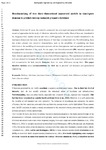Benchmarking of two three-dimensional numerical models in time/space domain to predict railway-induced ground vibrations

Use este enlace para citar
http://hdl.handle.net/2183/40426Colecciones
- Investigación (ETSECCP) [826]
Metadatos
Mostrar el registro completo del ítemTítulo
Benchmarking of two three-dimensional numerical models in time/space domain to predict railway-induced ground vibrationsFecha
2021Cita bibliográfica
Fernández-Ruiz, J., Medina Rodríguez, L. E., Alves Costa, P., & Martínez-Díaz, M. (2021). Benchmarking of two three-dimensional numerical models in time/space domain to predict railway-induced ground vibrations. Earthquake Engineering and Engineering Vibration, 20, 245-256. https://doi.org/10.1007/s11803-021-2017-8
Resumen
[Abstract:] In the last 30 years, the scientific community has developed and proposed different models and numerical approaches for the study of vibrations induced by railway traffic. Most of them are formulated in the frequency/wave number domain and with a 2.5D approach. Three-dimensional numerical models formulated in the time/space domain are less frequently used, mainly due to their high computational cost. Notwithstanding, these models present very attractive characteristics, such as the possibility of considering nonlinear behaviors or the modelling of excess pore pressure and non-homogeneous and non-periodic geometries in the longitudinal direction of the track. In this study, two 3D numerical approaches formulated in the time/space domain are compared and experimentally validated. The first one consists of a finite element approach and the second one of a finite difference approach. The experimental validation in an actual case situated in Carregado (Portugal) shows an acceptable fitting between the numerical results and the actual measurements for both models. However, there are some differences among them. This study therefore includes some recommendations for their use in practical soil dynamics and geotechnical engineering.
Palabras clave
Railway vibrations
Time/space domain
3D numerical model
Finite difference method
Implicit finite element method
Time/space domain
3D numerical model
Finite difference method
Implicit finite element method
Versión del editor
Derechos
This version of the article has been accepted for publication, after peer review (when applicable) and is subject to Springer Nature’s AM terms of use, but is not the Version of Record and does not reflect post-acceptance improvements, or any corrections. The Version of Record is available online at: https://doi.org/10.1007/s11803-021-2017-8





